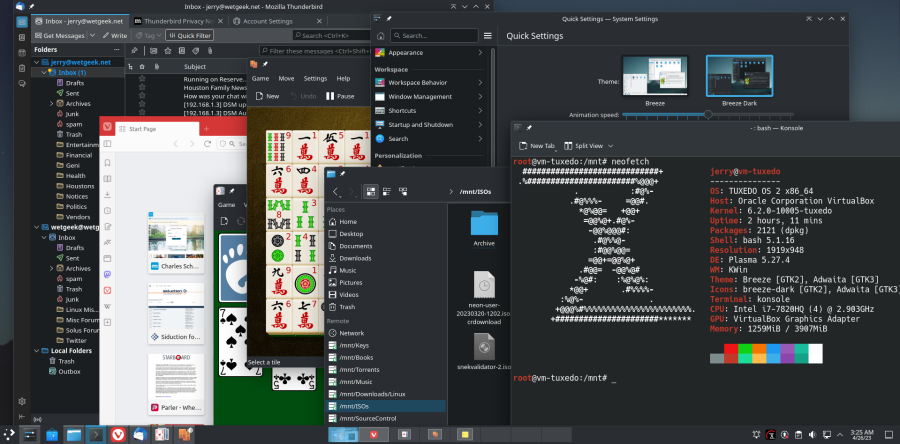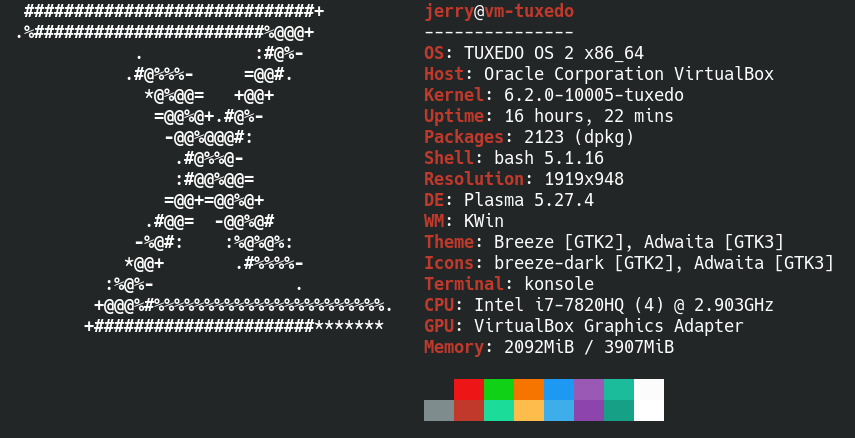Tuxedo OS, cont.
CONCLUSION
Here's the result of all this installing and configuring:

I would have to say that the devs at Tuxedo did an excellent job with my distro. Folks buying one of their machines should be very happy with it, provided it runs their OS as well as my DELL Latitude laptop does.
To finish my configuration, beyone those tasks already mentioned, I did the following (although not necessarily in this order):
- Fetched the Vivaldi .deb file from their website and installed it with Discover
- Added Lastpass to it, retrieved the Vivaldi password, and did a sync
- Installed Thunderbird, and configured two email accounts
- Installed Aisleriot, Kshisen, and Gnome-mahjongg from the repository
- Configured all the games as I would on my daily-driver laptop
Each application and game thus has its own workspace to run on. Having provided a swap partition during OS installation that supports hibernation, I exercised that feature several times while working with this VM, and it worked flawlessly. As with Solus, there was no ownership or permission problems accessing the contents of my mounted NAS shares with Dolphin. (Many of the distros I've worked with make doing that impossible, with access errors that I've never been able to resolve.)
Throughout all these tasks, not one single error was ever encountered. Not one. It's been like setting up a Solus Plasma VM. Tuxedo thus rates a A++ from me. The result is like a Solus VM except for the Ubuntu repos, of course. Apt instead of eopkg, for example.
The menu in the bottom panel is typical for a Plasma installation. I haven't opened every item to compared its contents with those on a Solus installation, but casual observation leads me to believe that they're probably identical (with the possible exception of the two Tuxedo OS utilities mentioned during the installation process.) Those are visible in the Favorites sub-menu, as shown below. Here's what the menu's contents look like:

Tuxedo OS is a rather smaller installation than Solus Plasma, although by an amount that might be explained by the number of snapshots I've taken of the Solus VM as I configured it. (I took one after each significant change in case I needed to restore the previous state because of a future problem.) The Tuxedo VM is almost exactly the same size as the Sparky Linux VM. Sparky is the distro that I used recently for at least two months as a Solus stand-in.
Tuxedo OS loads and enables 75 unit files on startup, which is well within the "medium" range for all the distros that I've observed. It's not quite as snappy as Solus is (Solus Plasma loads just 4 unit files), but startup and shutdown are not annoyingly slow with Tuxedo.

Continuing to praise Tuxedo OS any farther would probably serve no useful purpose, so I'll stop now. I'll just say that I used a couple of other Debian-based distros (Siduction, Sparky) as temporary Solus replacements during its recent troubles, and Tuxedo OS would have worked just as well as those did.
I posted a neofetch image in another message recently, but for convenience, and to keep it with this review, I'll post another here:
